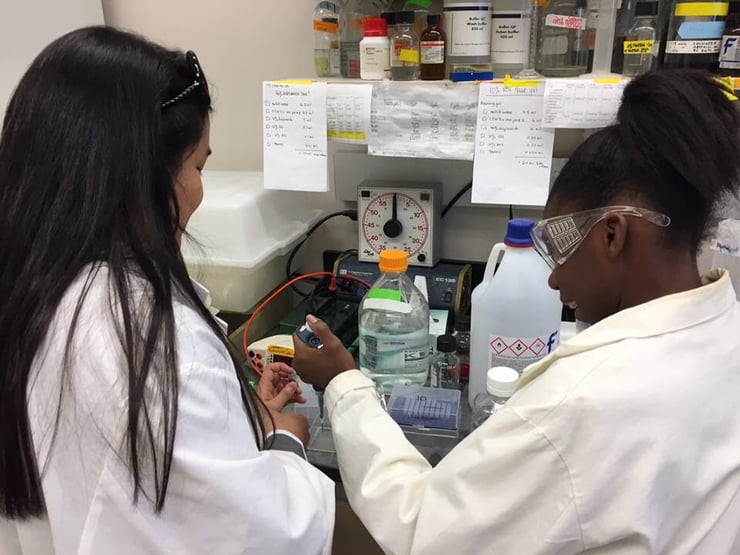For this week's "Antibody Applications" series, Lan Ho Wei will tell us about the principles of Enzyme-Linked Immunosorbent Assay (ELISA).
Lan is a post-doctoral fellow at Thomas Jefferson University in the Department of Biochemistry & Molecular Biology. Read on to understand ELISA principles and subtypes in 5 minutes!

What is the Principle of ELISA?
Enzyme-Linked Immunosorbant Assay, or ELISA, is a plate-based assay that detects and/or quantifies a target antigen in a heterogeneous mixture, such as a cell lysate, by utilizing enzyme-linked antibodies and chromogenic measurements.
The enzyme conjugated to the antibodies, typically alkaline phosphatase (AP) or horseradish peroxidase (HRP), acts as an amplifier of detection signal by converting a substrate that results in color changes in the wells.
There are 4 types of ELISA. Each differs by the method of antigen capture and/or signal detection:
1. Direct ELISA
The target antigen is first coated onto the multi-well plate, and then detected by an enzyme-linked 1' antibody.
Advantages:
- Simple and quick to perform due to minimal steps required
Disadvantages:
- Specificity of the primary antibody may be affected by the enzyme-linking
- Linking 1' antibody for each specific ELISA experiment is expensive and time-consuming
- Minimal signal amplification
2. Indirect ELISA
The target antigen, coated onto the multi-well plate, is first bound by a unconjugated 1' antibody, which in turn is detected by a enzyme-linked 2' antibody.
Advantages:
- Specificity of the 1' antibody is retained
- Many enzyme-linked 2' antibodies are commercially available
- Better signal amplification since multiple polyclonal 2' antibodies can bind to each 1' antibody
Disadvantages:
- Potential cross reactivity with 2' antibody leading to non-specific signal
3. Sandwich ELISA
Sandwich ELISA is often performed using commercially available kits since an antibody pair that targets two distinct epitopes on the target antigen is required.
The first antibody, or the capture antibody, is coated to the multi-well plate. The sample containing target antigen is added, followed by the detection of the antigen by the detection antibody that is enzyme-linked. Hence, the target antigen is "sandwiched" between the capture and detection antibodies.
Either direct or indirect detection can be used in a sandwich ELISA.
Advantages:
- High specificity since the signal detection requires the binding of two 1' antibodies
- Crude sample can be used: target antigen-antibody complex is immobilized to the plate, and everything else can be washed off
Disadvantages:
- Commercially-prepared kits may not be available
4. Competitive ELISA
Competitive ELISA is based on the competition binding for the 1' antibody between the target antigen in a sample and the same antigen that is coated to the multi-well plate.
The 1' antibody is first added to the sample to form antigen-antibody complexes. The sample is then added to the wells that are coated with the target antigen. Only the unbound 1' antibody in the sample can bind to antigen coated in the wells. Hence, the more antigen in the sample, the less antibody is available to bind to antigen in the wells, resulting in a signal reduction.
Either direct or indirect detection can be used in a competitive ELISA.
Advantages:
- High sensitivity
- Crude sample can be used
- Signal can be quantified by comparing to a serial dilution standard curve
Disadvantages:
- Requires 1' antibodies with high specificity to the antigen
 Image credit: BosterBio
Image credit: BosterBio
Summary Table
| Direct | Indirect | Sandwich | Competitive | |
| What is coated on the plate? | Antigen | Antigen | Capture 1' Ab | Antigen |
| The enzyme is linked to? | 1' Ab | 2' Ab | Detection 1' Ab / 2' Ab | 1' Ab / 2' Ab |
| Antigen detection in your sample? | No | No | Yes | Yes |
In the next post, I will discuss how to decide which type of ELISA to use, as well as some bench tips when performing an ELISA.
In the mean time, check out BenchSci to search for ELISA antibodies and kits that have been published to plan your experiment!

